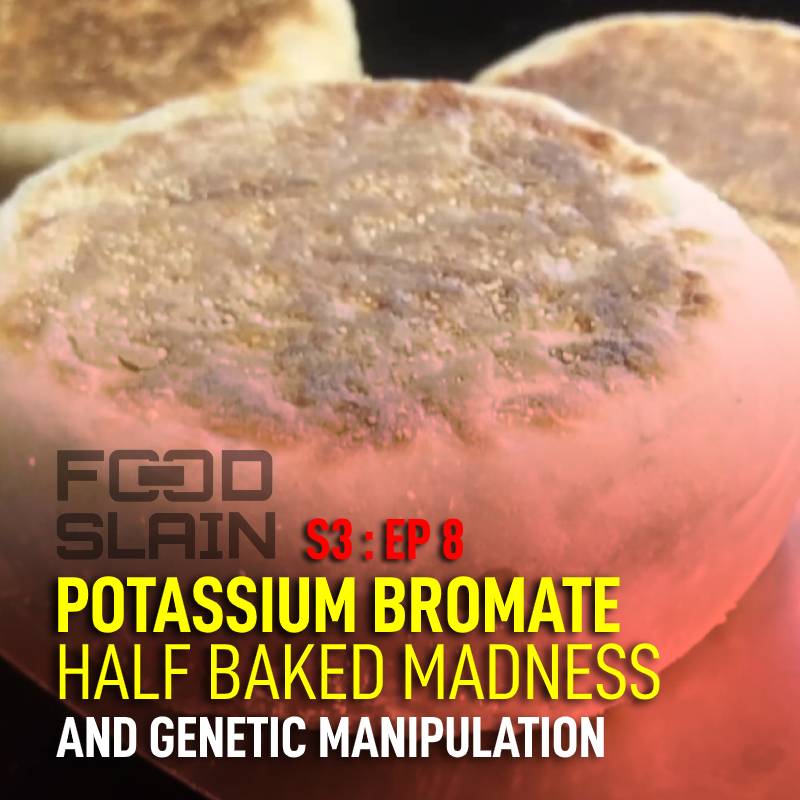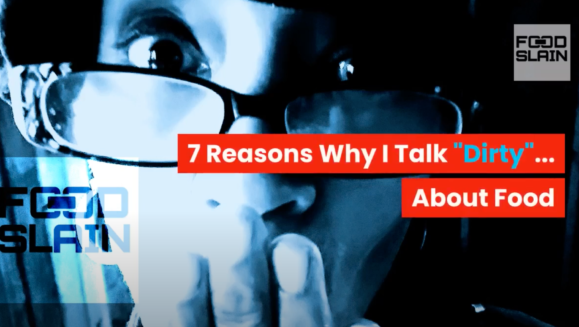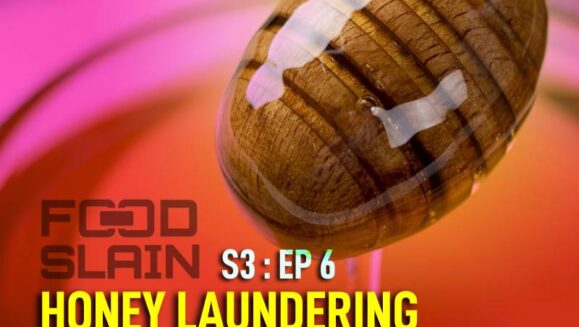Today we’re talking about bread.
If you’re a regular listener to this podcast, then (thank you) you know that last week I interviewed Dr. David Killilea, and the topic was whole grains and whole wheat from a biochemical and health perspective and he talked about the discovery in his research that, not all whole grain and whole wheat flours are created equally. A few contain 100% whole wheat as they claim, yet many others do not.
In fact, most of the flours that were tested by Dr. Killilea only contains just over the USDA required amount of whole grains and whole wheat, which is 51%.
Given that little tidbit of information, I thought it would be a good idea to look into a food that most of us eat every day, which is the topic of the day, bread. More specifically, potassium bromate and azobicarbonomide. Azodicarbonamide (ACA), is a chemical that forms bubbles in foams and plastics like vinyl, but in this case, it is used to bleach and leaven dough. Potassium bromate is an additive that is used to accomplish a few things. It helps breads rise higher, it acts as a dough conditioner and it makes baked breads appear lighter in color. Sadly, this additive also accomplishes a few things that might really take the joy out of eating bread for some of us, namely disrupting genetic information in the cells of the body.
And if that’s not enough of a bummer, potassium bromate is banned in many countries around the world, but not in the United States. Countries in the EU banned it over a decade ago, and other countries like Canada, South Korea, Peru and Brazil banned it on the basis that it is a possible carcinogen. It was also banned in Sri Lanka in 2001, China in 2005 and India in 2016.
So, I bet you’re thinking….
If it’s banned in all these countries, why hasn’t it been banned in the US? That’s a good question. And that’s what we’re digging into today.
But before we do, I’d like to just shout out all the people who listen to this podcast. You are the reason I plow through the technical issues, stay up late and do the work. These are challenging times for all of us. There is so much going on and there is just a lot of information out there that we are taking in each day and I am humbled and truly grateful that you choose to listen in to THIS podcast. Thank you. I also want to just mention a few folks who have suggested the topic of bread over the past few months – so a big shout out to Jeff and Dante and also to Alex who sent me a link to an article on Subway bread which served as a good reminder that now’s the time to dig into this topic.
Ok.
So, what is potassium bromate?
Scientifically speaking, it is a chemical compound that is produced when bromate passes through a hot solution of potassium hydroxide. It is used as an additive in flour to increase the strength and elasticity of the flour and to also allow for higher rising (because who doesn’t like a sandwich on a fluffy, chewy roll). It’s also used to give baked bread a whiter color possibly instead of using bleach.
What is azobicarbonomide?
Also known as ACA, it was discovered in the late 1950’s and entered the bread supply by the early 60’s. Unfortunately, during it’s use in the 70’s, but 1980 the workers who handle these yellow crystals, were exposed to the chemical while manufacturing plastics. The real concern for those of us who eat bread is, when ACA is heated or baked, it breaks down into two chemicals : semicarbazide and urethane.
According to the US Dept of Health and Human Services says “Urethane is “reasonably anticipated” to be a human carcinogen, while semicarbazide has shown toxicity in some animals, but not yet humans.”
Potassium bromate has been classified as a “possible carcinogen” by the state of New Jersey – especially for people who are handling it (like flour manufacturers), and the state of California requires products that contain potassium bromate to be labeled as such according to it’s Proposition 65 list.
Here’s a quote from the US National Library of Medicine from a study on the Toxicity and carcinogenicity of potassium bromate.
“Potassium bromate (KBrO3) is an oxidizing agent that has been used as a food additive, mainly in the bread-making process. Although adverse effects are not evident in animals fed bread-based diets made from flour treated with KBrO3, the agent is carcinogenic in rats and nephrotoxic in both man and experimental animals when given orally. It has been demonstrated that KBrO3 induces renal cell tumors, mesotheliomas of the peritoneum, and follicular cell tumors of the thyroid.”
So, too bad for the rats, but for us, we get to eat as many garlic breadsticks, sourdough bread slices, sandwiches, baked breads and packaged breads as we want with it in there because in the US it is still considered to be GRAS…generally regarded as safe.
And that’s a problem of the FDA. They are not able to review every single additive that is in our food. Instead, companies typically rely on their own paid experts (whatever that means) to determine what is safe and what is not because once something is declared as safe, or GRAS,
there’s really no incentive for companies or the FDA to do any additional testing.
Senior scientist, Lisa Lefferets at the consumer advocacy group Center for Science in the Public Interest who specializes in food additives says, “The system for ensuring that ingredients added to food are safe is broken, and that once a substance was in the food supply, the FDA rarely took further action, even when there was evidence that it isn’t safe.”
The Center for Science in the Public Interest petitioned the FDA to ban potassium bromate two decades ago due to cancer concerns, but the FDA’s response, according to a letter from the agency, was that it couldn’t examine the issue due to “limited availability of resources and other agency priorities”.
However, in an article published on the Environmental Working Group website in 2015 on potassium bromate, it states, and I quote “Despite the significant evidence of potassium bromate’s harmful health effects, the food industry has long argued that it is of no concern in baked products. The industry claims potassium bromate is theoretically fully converted into potassium bromide, a similar yet non-carcinogenic chemical, during baking. But testing in the United Kingdom revealed that potassium bromate remains detectable after baking, with six out of six unwrapped breads and seven out of 22 packaged breads containing measurable levels.”
It’s not just so-called dough conditioners in bread. There’s other stuff in there too…
Two preservatives, BHA and BHT, subject to strong restrictions in the EU, are widely used in baked goods in the US. These emulsifiers keep fats and oils from spoiling, but the International Agency for Research on Cancer suggests there is sufficient evidence that BHA causes tumor growth in lab animals, with more limited evidence for the same in BHT.
The data on humans is lacking, but the FDA has allowed these ingredients in small amounts since before the 1950s. “The FDA has studied the use of BHA and BHT in foods for decades and has determined that at the very low levels at which they are used, they do not pose safety concerns,” the agency spokesperson said.
While some companies are removing controversial ingredients, their replacements aren’t necessarily much better or all that different.
“A number of other companies have switched from potassium bromate to potassium iodate in their bread, but potassium iodate is not well tested and may also pose a slight cancer risk,” Lefferts said. “It might also lead to excessive iodine intake. While iodine is an essential trace element that the body needs, too much can be harmful.”
The World Health Organization has recommended against adding potassium iodate to flour since 1965, yet the EWG lists more than 600 products that include potassium iodate, including Sara Lee hot dog buns, Safeway’s Signature Select whole wheat bread and Oroweat Italian bread.
So, companies use bromated flour in their breads, and we’re not just talking about loaves of bread in the store.
We’re talking about frozen foods (like perhaps chicken pot pie, meat patties and other foods that are so deliciously wrapped in bread), packaged dough (like ready to bake breadsticks and pizza dough), baked breads at restaurants, cafés and deli’s and even pastries. Like toaster pastries!
So, here’s a quick story. I was scouring the internets for information and came across this video clip from a series that came out in 2008 called Fringe created by JJ Abrams, Alex Kurtzman and Roberto Orci. If you’ve never heard of it, because I hadn’t, the premise is An F.B.I. agent is forced to work with an institutionalized scientist and his son in order to rationalize a brewing storm of unexplained phenomena.
One of the clips from the pilot episode is of this scientist walking through a grocery store. He picks up a box of toaster pastries and tries reading the ingredients list but he can’t read them because he needs his readers. I know how he feels. I can’t read anything smaller than 12 point without my readers too. And if you’re like me, you need your readers in the grocery store. So he grabs a set of readers from a nearby rack and starts reading the ingredients. Corn starch, soy lecithin, potassium bromate…??? And then he just shouts, potassium bromate? Of course, the hush descends over the store and as he gets the attention of a nearby employee of the store, he screams out, “this supermarket is trying to kill us!” Then he points at the employee and says, “you…potassium bromate do you know what that is?” and the employee starts asking him ‘are you okay, sir?” As if to say something is wrong with him, but this scientist guy is trying to tell him what’s wrong with potassium bromate.
The scientist goes on to loudly school this young employee saying “it’s known to induce renal cell tumors, mesotheliomas of the peritoneum…” and the employee keeps on and asks him, “is there someone I can call for you?” the scientist responds….’you know what you are putting into our bodies. Death.’ and he smacks the box and says…”delicious straaaawberry flavored death.” and he hurls the box to the ground. The employee is like “I’m going to call security”…and the scientist is like “yeeeeesss”…then some of the surrounding shoppers scuttle away and our scientist guy feels defeated, and confused. As if he just can’t believe what has happened to the world… and he shrinks down to the floor, head in hand weeping.
That’s how I feel when I read labels too. And I’m no scientist and I’m not on TV…but anyway….
Here are a few things we should know…
As consumers, we each eat an average of 53 pounds of bread every year! With that much bread, potentially laden with potassium bromate and other additives, going into our bodies, it begs the question, how did we get here?
Last week when we talked to Dr. David Killilea, he talked about how our whole grains and whole wheat used to be stone ground, but for ease and convenience, our grains are now milled on steel rollers. White flour just became easier to mill and it lasted longer (because we removed the bran and germ).
So with white flour as a dietary staple, companies figured out how to keep us buying them.
They figured out how to increase shelf life of baked goods, how to make them more appealing to our taste buds and our eyes – by figuring out how to make them fluffier and whiter. And for that convenience, the tradeoff is, we can now potentially destroy the genetic material in our cells (specifically in our intestines) or get cancer. Juuuust great.
So, beyond dough conditioners in bread, there are other additives lurking in those english muffins and loaves we’re eating. There are preservatives like BHT and BHA, there are artificial flavorings and artificial colorings, there’s added sugar and monoglycerides, AND there’s GMO’s from the oil used in them (like corn, canola and soybean oils) or there’s GMO wheat that has been sprayed with chemical pesticides. – which if you listened to my episode on toxic beans and cereal grains, you know the dealy-o.
So what can we do about it?
The good news is, many fast food companies like White Castle, Subway, McDonalds and Wendys have dumped using azobicarbonomide in their products in 2014. However, there are still a lot of products out there in that big ol’ grocery store with these ingredients.
I personally make my own bread if I can.
If you follow me on social media, you probably saw my post about my sourdough english muffins that I was making at 2am. I have a sourdough starter that I’ve been keeping alive since 2017 and about every 10 days, I make a batch of the most delightful english muffins. It takes time, as anything that’s worth it does…but they are delicious – and free of all these substances. There’s tradeoffs….uh, either I pay now in taking the time to make clean food, or later I suffer the potential genetic cellular destruction or mesothelioma tumors in my lung, heart, stomach tissues. Right? It’s a choice.
So, that’s one thing you can do…make your own bread with real flour or non-bromated flour. I suggest using organic flour at the very least, and if you can, use 100% whole grain flour (like the one’s we talked about in the last episode) to make breads.
Another thing you can do is eat organic bread.
One of the people who suggested this topic eats Ezekial Sprouted Grain bread…which is GREAT because there isn’t any flour in that bread. Most organic products cannot contain these types of ingredients, but do your due diligence. Remember, we’re eating more than one pound of bread each week…
Bread has been around for thousands of years. Some historic records say the earliest indication of bread came from the Middle East around 8000 BC. Of course, it wasn’t this fluffy, yeasted bread it was likely something more like a flat bread, unleavened and probably not very tasty but it had to be made and consumed quickly. I remember visiting Morocco in the late 90’s and walking around in Marrakkesh and there were small brick oven bakers baking bread for all the townspeople. It was the most delightful thing to see and smell and that’s how we used to live in society. We’ve gotten away from baking bread because we’re too busy. However, there’s been a surge in baking bread at home since the pandemic…so that’s the bright side.
But the problem exists primarily in our commercial food production.
It’s a little tougher to discern the ingredients in the commercial food industry. When you go out to a restaurant and they bring you a basket of warm, toasty bread – what are you going to do? Ask them…”does this bread have potassium bromate in it?” Your server probably has never even heard of that before, let alone know whether the bread they’ve just served you contains this additive. The best we can do is either turn that bread away, or ask the restaurant owner where they procure their bread – and do our own research.
There are a lot of factors at play when we start to think about WHY we get sick or get diseases that negatively impact our cells and bodies and we can make assumptions about the causes, but causation isn’t the same as correlation. There is a clear correlation between food and health outcomes – and that’s what we have to understand as consumers. These food manufacturers know it too, but remember, they’re running a business. AKA, trying to make a profit and convince us to stay loyal as consumers by adding unnecessary ingredients to our food supply.
So that’s where I’m gonna leave this one.
What do you think about potassium bromate and azodicarbonomide? Should it be in our bread and foods that we feed to our children? Should we be taking our FDA to task to develop protocols for testing these chemicals that are determined as GRAS?
What do you think….let me know on the socials.
You can follow me on Twitter, FB and IG @foodslain. Or, subscribe to the YT channel where we can also continue the discussion.
In the meantime, I thank you for listening to this episode and I hope you share it with someone you love. Thank you to my patrons on Patreon, I really appreciate your support. If you’d like to support this podcast, head on over to Patreon.com/foodslain. Next week, we’re going to be digging into the connection between language and food and the impacts of commercial food production on the environment with a fellow podcaster on the Climate Front Lines so make sure to listen in.
Until then, remember to eat clean, eat healthy and love your food, and I’ll see you on the other side of the plate.
Chow.



